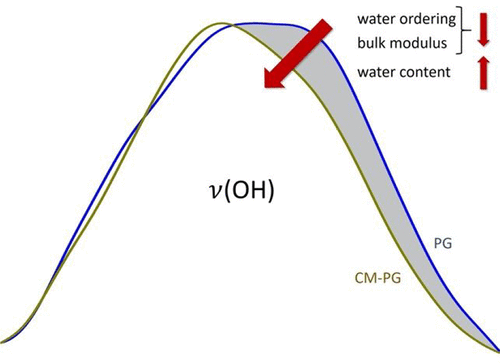当前位置:
X-MOL 学术
›
Biomacromolecules
›
论文详情
Our official English website, www.x-mol.net, welcomes your feedback! (Note: you will need to create a separate account there.)
Hydration Water Structure, Hydration Forces, and Mechanical Properties of Polysaccharide Films
Biomacromolecules ( IF 6.2 ) Pub Date : 2020-10-16 , DOI: 10.1021/acs.biomac.0c01098 Michael Grossutti 1 , John R Dutcher 1
Biomacromolecules ( IF 6.2 ) Pub Date : 2020-10-16 , DOI: 10.1021/acs.biomac.0c01098 Michael Grossutti 1 , John R Dutcher 1
Affiliation

|
The interaction of polysaccharides with water has a critical impact on their biological function as well as their technological applications. We performed ellipsometry experiments at different relative humidities (RH) to measure the equilibrium swelling of ultrathin films of different polysaccharides: native and modified phytoglycogen (PG) nanoparticles, dextran, and hyaluronic acid. For RH > 70%, the swelling of hydrophilic polymers with increases in RH is described by hydration forces that are characterized by an exponential decay length λ. Our analysis of the high RH swelling regime allowed us to determine λ and the bulk modulus K of the films of different polysaccharides. We also probed the high RH swelling regime using attenuated total reflection infrared (ATR-IR) spectroscopy, which allowed us to determine the degree of hydrogen bonding of the hydration water within the polysaccharide films. Combining the ellipsometry and ATR-IR spectroscopy results, we find that increases in the order of the hydrogen bond network of the hydration water, as specified by the ATR-IR parameter Rnetwork, lead to linear increases in K and corresponding inverse changes in λ. These measurements help to elucidate the intimate relationships between the degree of ordering of hydration water, hydration forces, and the mechanical stiffness of polysaccharides. For phytoglycogen, the addition of chemical groups, both cationic and anionic, produced significant increases in its water holding capacity and mechanical properties, suggesting that chemical modification can be used to tune the properties of phytoglycogen for different applications.
中文翻译:

多糖膜的水合水结构,水合力和力学性能
多糖与水的相互作用对其生物学功能及其技术应用具有至关重要的影响。我们在不同的相对湿度(RH)下进行了椭偏实验,以测量不同多糖(天然和修饰的植物糖原(PG)纳米颗粒,葡聚糖和透明质酸)的超薄膜的平衡溶胀。对于RH> 70%,亲水聚合物随RH的增加而溶胀的特征在于水合作用力,其特征是指数衰减长度λ。我们对高RH溶胀状态的分析使我们能够确定λ和体积模量K不同的多糖薄膜。我们还使用衰减全反射红外(ATR-IR)光谱技术探测了高RH溶胀状态,这使我们能够确定多糖薄膜中水合水的氢键程度。结合椭圆偏光法和ATR-IR光谱结果,我们发现按照ATR-IR参数R网络所指定的顺序,水合水氢键网络的顺序增加,导致K线性增加以及相应的λ逆变化。这些测量有助于阐明水合水的有序度,水合力和多糖的机械刚度之间的密切关系。对于植物糖原而言,阳离子和阴离子化学基团的添加均会显着提高其持水量和机械性能,这表明化学修饰可用于调整植物糖原在不同应用中的性质。
更新日期:2020-12-14
中文翻译:

多糖膜的水合水结构,水合力和力学性能
多糖与水的相互作用对其生物学功能及其技术应用具有至关重要的影响。我们在不同的相对湿度(RH)下进行了椭偏实验,以测量不同多糖(天然和修饰的植物糖原(PG)纳米颗粒,葡聚糖和透明质酸)的超薄膜的平衡溶胀。对于RH> 70%,亲水聚合物随RH的增加而溶胀的特征在于水合作用力,其特征是指数衰减长度λ。我们对高RH溶胀状态的分析使我们能够确定λ和体积模量K不同的多糖薄膜。我们还使用衰减全反射红外(ATR-IR)光谱技术探测了高RH溶胀状态,这使我们能够确定多糖薄膜中水合水的氢键程度。结合椭圆偏光法和ATR-IR光谱结果,我们发现按照ATR-IR参数R网络所指定的顺序,水合水氢键网络的顺序增加,导致K线性增加以及相应的λ逆变化。这些测量有助于阐明水合水的有序度,水合力和多糖的机械刚度之间的密切关系。对于植物糖原而言,阳离子和阴离子化学基团的添加均会显着提高其持水量和机械性能,这表明化学修饰可用于调整植物糖原在不同应用中的性质。



























 京公网安备 11010802027423号
京公网安备 11010802027423号